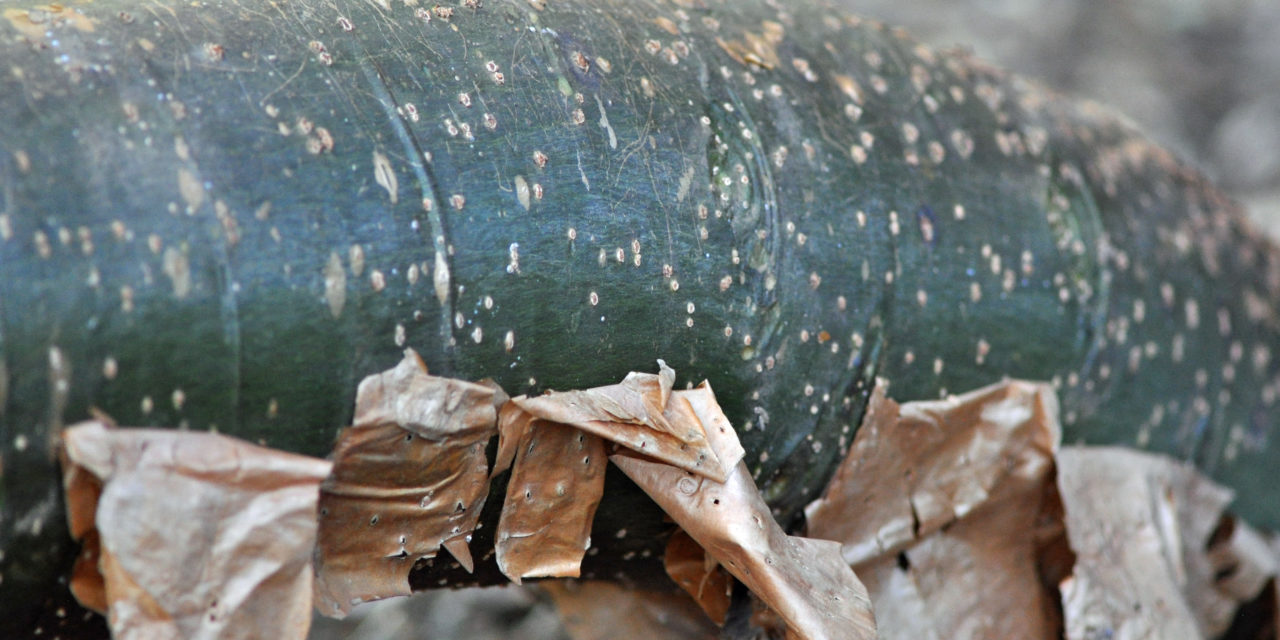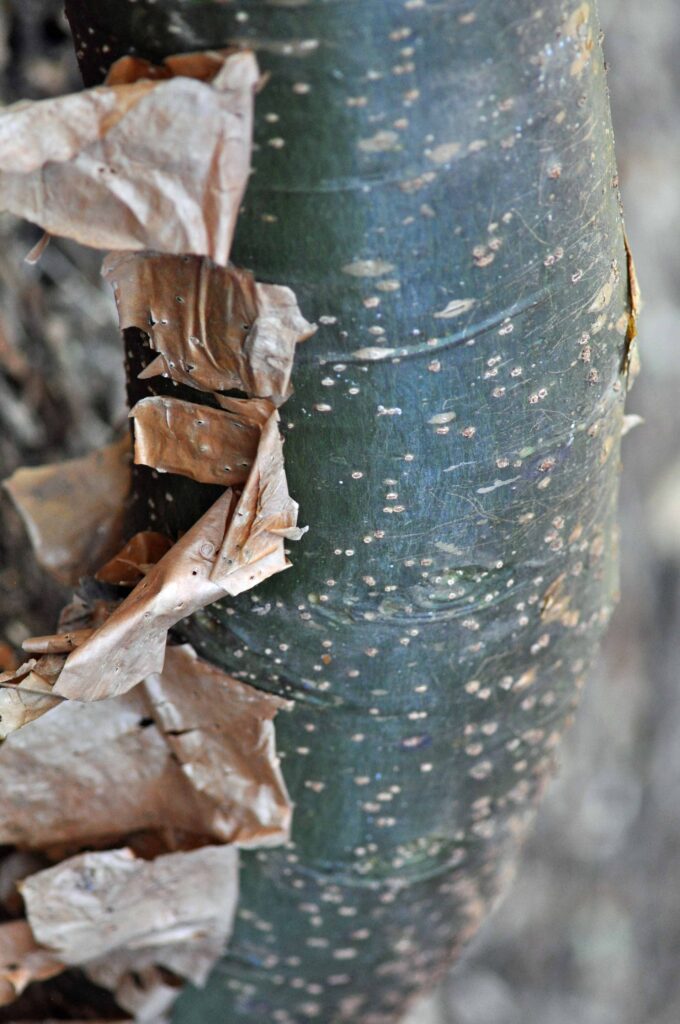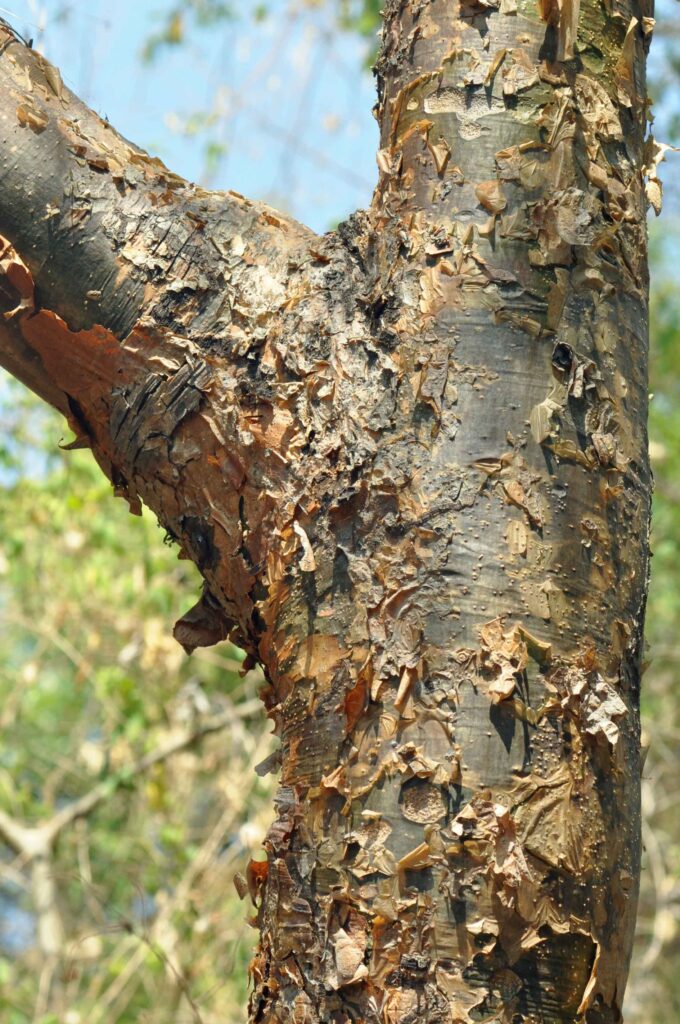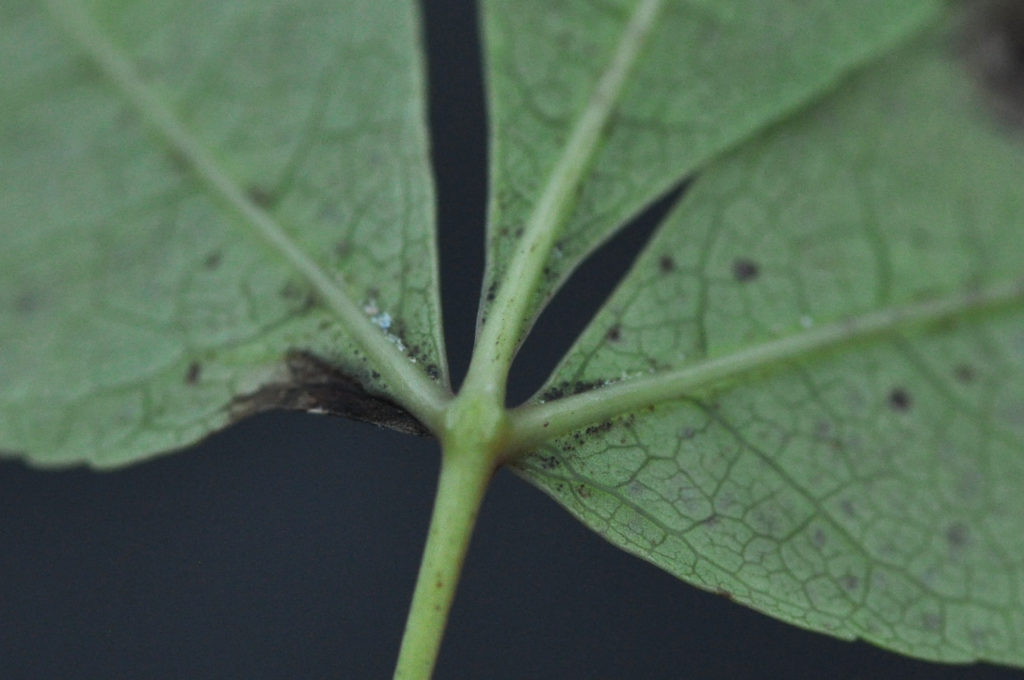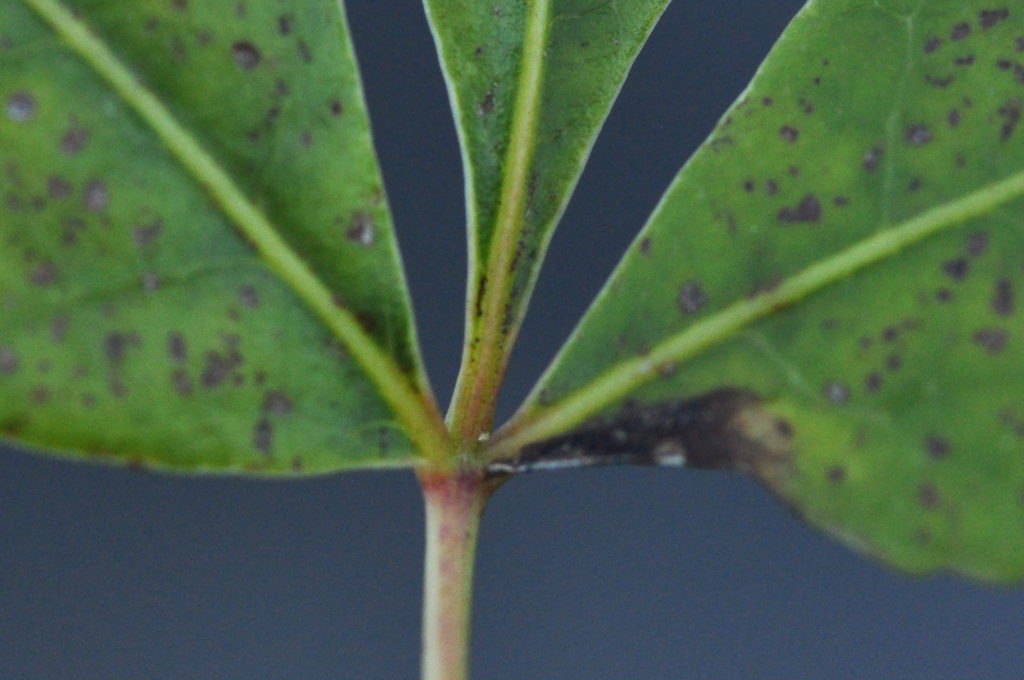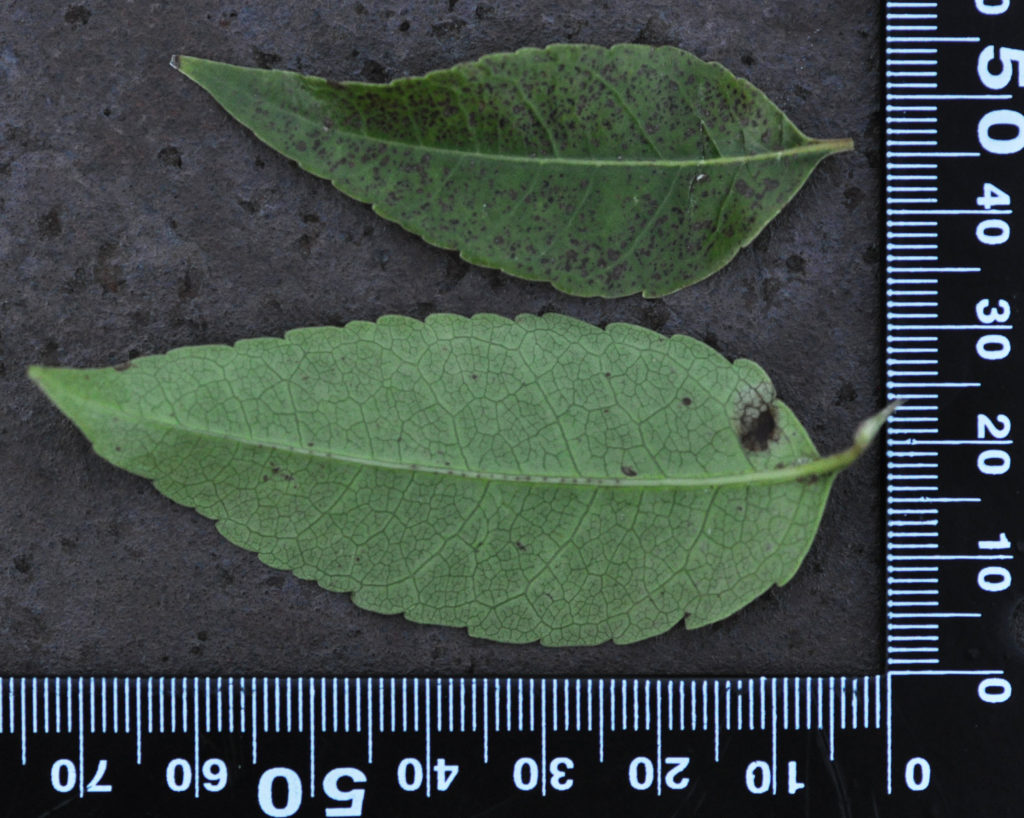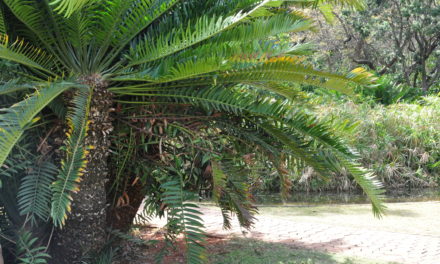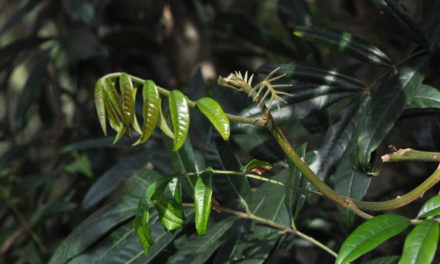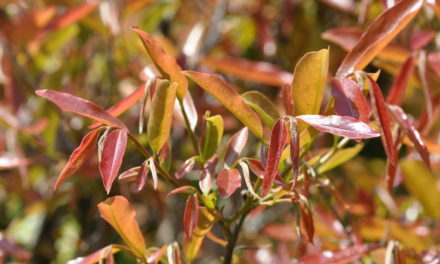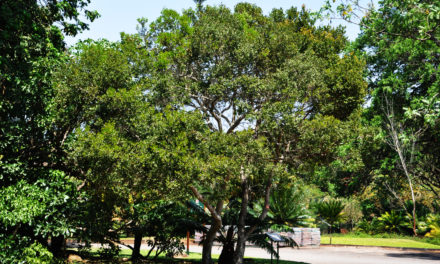General Info – summary
This spineless, medium sized Tree has a papery flaking bark. Coppery bark peels off showing dark green photosynthetic underbark. Imparipinnate Leaves have up to 7 leaflets. Small, dioecious, regular, 4-merous, insect pollinated Flowers are in panicles. Male flowers have 8 stamens. Females have a superior ovary + a short style & capitate stigma. Stalked Fruit is a 1cm wide, 1-seeded drupe with a red arilode.
Description
Previous Names: Protium africanum, Balsamea harvyi.
SA Tree No. 277.
Common names: (Afr) Bruin-kanniedood, Kopperstamkanniedood, Rooistam-kanniedood. (Eng) Copper-stem Corkwood, Cork Tree, Corkwood, Harvey’s Cork Tree, Red-stem Corkwood. (siSwati) Umbangandlala, umNumbi. (isiXhosa) Ulonwabo, Umhlunguthi. (isiZulu) Ihlunguthi, Iminyela, Iminyele, Umbumbungane, Uminyela, Umumbu, Usingankomo.
Family: Burseraceae (The torchwood family, which includes frankincense from Boswellia sacra, myrrh from Commiphora myrrha both of which have an incense like odour). Neither Boswellia species nor Commiphora myrrha are indigenous in southern Africa. Non-allergenic resin occurs in most plant tissues. Worldwide there are about 16 genera and in excess of 500 species, which occur in tropical South America, Malaysia and Africa. In South Africa Commiphora is the only genus and there are about 20 species that may be regarded as trees. The Bark is smooth, aromatic and pealing or flaking in small pieces. The Leaves are resinous and usually without stipules. The usually dioecious Flowers have 4 or 5 petals and sepals that are imbricate (having regularly arranged, overlapping edges, as roof tiles). Flowers are actinomorphic (regular, symmetric) and the Stamens are double or equal to the number of petals. The superior Ovary has 3-5 carpels with 2 ovules in each and the single Style ends in a capitate (forms like a head) or lobed Stigma. The pitted Fruit is often an edible drupe.
Name derivation: Commiphora Greek: kommi – gum and phora – bearer. harveyi – named after W.H. Harvey (1811-1866) an Irish botanist and co-editor of the first 3 volumes of Flora Capensis (a systematic description of the plants of the Cape Colony, Eastern Cape, & Port Natal).
Conservation: National Status: L C. (Least Concern). Assessment: Raimondo et al. (2009).
Tree
This spineless Tree may reach 20m high. However, it is usually a much smaller, squat tree up to about 7m. The green smooth Trunk (photo 379) may appear succulent. The Bark usually peels or flakes off in large bronze-coloured, papery flakes (photo 379) small pieces or in thick discs. This loss reveals the dark green, photosynthetic underbark tissue (photo 379). There are odoriferous Resin ducts present in the bark from which resin and sap flows when the bark is damaged. Young Branchlets are fluted (grooved, funnelled or channelled) and have visible light coloured pale Lenticels (usually raised corky oval or elongated areas on the plant that allow the uncontrolled interchange of gases with the environment – photo 379). Small branches do not end in spine tips.
- 379. 2018/09/11. Kirstenbosch NBG. Photo: David Becking.
- 653. 014/09/13. Lowveld NBG. Photo: David Becking.
Leaves
This deciduous tree may be without Leaves for months. The water saving photosynthetic bark compensates for the loss of leaves. When they do appear, the alternate leaves are clustered at the ends of branchlets. The resinous leaves become large – up to 20cm long. They are imparipinnate (pinnately compound leaf ending in a single leaflet) and may be trifoliate – with only 3 leaflets (photo 385). Leaflets are usually thin. The terminal single leaflet is the biggest – up to 8 x 3cm (photo 384). Paired leaflets are up to 6 x 2,5cm (photo 386) and may be lanceolate (lance-shaped) or ovate (egg-shaped) or elliptic. They are dark green and shiny above. Leaflets turn bright yellow before falling. The leaflet Apex tapers and may end in a drip-tip, and the Base tapers. Leaflet Margins may be scalloped (having the margin marked with segments of circles – usually less than a semi-circle – photo 384) to serrate (saw-toothed margin with teeth pointing forward – photo 384). The thin Petiole (leaf stalk) is purplish red when young (photo 386) and up to 6cm long when mature. The Petiolules (leaflet stalks – photo 385) are up to 1,5cm long. Stipules (basal appendage of the petiole) are absent.
- 385. 2018/09/11. Kirstenbosch NBG. Photo: David Becking.
- 386. 2018/09/11. Kirstenbosch NBG. Photo: David Becking.
- 384. 2018/09/11. Kirstenbosch NBG. Photo: David Becking.
Flowers
This tree is dioecious (having male and female parts on separate plants). The yellow to green flowers are small (up to 33mm long), cup-shaped and actinomorphic (Regular, symmetrical. Flowers are vertically divisible into similar halves by more than 1 plane passing through the axis). They develop in axillary heads up to 13cm long. Flowers have long (up to 1cm) Peduncles (stalk of flower cluster) that are usually attached to young wood. The funnel shaped Calyx has 4 persistent Sepals which are united at the base. The bell-shaped Corolla has 4 whitish Petals that alternate with the sepals. A cylindrical Disc (a more or less fleshy or elevated development of the receptacle) is present. The Male flowers are usually larger than female flowers. Here the 8 Stamens have Anthers that are introrse (turned or faced inward or toward the axis with a longitudinal line of dehiscence facing towards the flower centre). A rudimentary ovary is present. In the Female flowers, there is a single Pistil (a unit of the Gynoecium, the female element of the flower, composed of the Ovary, Style and Stigma). Here Staminodes (sterile stamens) are present. The 2-locular Ovary has a short Style that terminates in a capitate (formed like a head) Stigma. Flowers are Pollinated by insects. (Oct-Dec).
Fruit
The ovoid or spherical Fruit is initially cream to yellowish green and develops into a pinkish-red Drupe (a fleshy, 1-seeded indehiscent fruit with the seed enclosed in a stony endocarp; stone fruit e.g., peach). It is up to 1,2cm wide and is situated on a stalk. The fruit is initially a mottled green that turns red (and is up to 1cm wide) when ripe. The 4-lobed (2 long and 2 short lobes) outer covering is easily removable with the fingers. Below this is the putamen (endocarp; the shell of a nut; the stone of a drupe fruit). This is clasped at the base by a prolonged orange or red arilode (a structure in certain seeds that resembles an aril but is developed from the micropyle of the ovule as opposed to the stalk). Within the putamen is a single fertile black seed in one locule and a single abortive ovule in the other locule. (Nov-Mar).
Distribution & Ecology
This plant is a southern African Endemic (restricted to a particular geographic location). These Trees survive in dry areas. They grow in hot dry forests and valleys – in bushveld as well as in rocky outcrops e.g. granitic and dolerite rocks. Both are intrusive igneous rock that may form outcrops. Commiphora harveyi may also make up part of coastal forests. These plants are Located from East London, in the Eastern Cape – especially on north facing slopes on red dolerite (or diabase: from hard igneous rock intrusions of basaltic composition) soil, Kwazulu-Natal bushveld, and Limpopo. In Mpumalanga, they often occur in kloofs (steep-sided, wooded ravines or valleys). This plant also grows in Swaziland – in ravines of the Lebombo Mountains, and in southern Mozambique. Klipspringer (a small antelope found in the eastern part of southern Africa – usually on rocky areas) consume the Leaves, and elephants eat the Roots and Stems. Monkeys and birds eat the Fruit.
Ethnobotany
Household instruments like dishes and spoons as well as beer stools are made from the low-density soft white Wood. Local people eat the soft moist wood in times of water and food shortage. Living fences can be grown from cuttings. Wood is carved into holders for beer strainers. Trees should be planted in frost-free areas. Young crushed leaves are fragrant. This plant makes a good bonsai tree. Parts are used in local medicine. They are used as an insect repellent and to produce incense. N.B. for fruit, both male and female plants are required and selected truncheons (stem cutting from a selected plant – used to produce genetically identical new plants) are the best way to achieve this.
References
Boon, R. 2010. Pooley’s Trees of eastern South Africa. Flora and Fauna Publications Trust, Durban.
Burrows, J.E., Burrows, S.M., Lotter, M.C. & Schmidt, E. 2018. Trees and Shrubs Mozambique. Publishing Print Matters (Pty) Ltd. Noordhoek, Cape Town.
Coates Palgrave, M. 2002. Keith Coates Palgrave Trees of Southern Africa, edn 3. Struik, Cape Town.
Lawrence, G. H. M, 1951. Taxonomy of Vascular Plants. The Macmillan Company, New York. Tenth Printing 1965.
Palmer, E. & Pitman, N. 1972. Trees of southern Africa. Balkema, Amsterdam, Cape Town.
Schmidt, S. Lotter, M. & McCleland, W. 2002. Trees and Shrubs of Mpumalanga and the Kruger National Park. Jacana, Johannesburg.
van Wyk, B. & van Wyk, P. 1997 Field guide to Trees of Southern Africa. Struik, Cape Town.
van Wyk, B. & van Wyk, P. 1997 Field guide to Trees of Southern Africa. Struik, Cape Town.
Victor, J.E. & Dold, A.P. 2005. Commiphora harveyi (Engl.) Engl. National Assessment: Red List of South African Plants version . Accessed on 2024/09/06.
http://www.greenplanet.co.za/plant.php?plant=387
http://www.plantzafrica.com/plantcd/commiphora.htm
http://posa.sanbi.org/flora/browse.php?src=SP
http://archivedpublicwebsite.up.ac.za/default.asp?ipkCategoryID=20877&subid=20877

